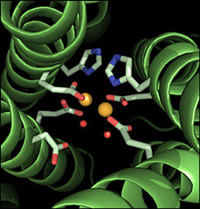Biological wires carry electricity thanks to special amino acids
Slender bacterial nanowires require certain key amino acids in order to conduct electricity, according to a study to be published in the journal of the American Society for Microbiology.
In nature, the bacterium Geobacter sulfurreducens uses these nanowires, called pili, to transport electrons to remote iron particles or other microbes, but the benefits of these wires can also be harnessed by humans for use in fuel cells or bioelectronics. The study in mBio® reveals that a core of aromatic amino acids are required to turn these hair-like appendages into functioning electron-carrying biological wires.
"It's the aromatic amino acids that make it a wire," says lead author Derek Lovley of the University of Massachusetts, Amherst. Lovley and his colleagues removed the pivotal amino acids from the pili and replaced them with smaller, non-aromatic amino acids. Without these key components, Lovley says, the pili are nothing more than protein strings. "We showed it's not good enough to just make the string - you've got to make a wire," says Lovley.
G. sulfurreducens "breathes" by removing electrons from organic materials and funneling them to iron oxides or to other microorganisms, much the way humans pull electrons out of organic molecules in food and dump them on oxygen. The bacteria use their pili to reach out to iron oxides or other microbes, transferring the "waste" electrons along the structure to the destination. Geobacter's pili are only 3-5 nanometers wide, but they can be 20 micrometers long, many times longer than the cell itself.
Trafficking in electrons is how all living things breathe, but it is normally carried out by discrete proteins or other molecules that act like containers for shuttling electrons from one place to another. Lovley says earlier results showed the pili in G. sulfurreducens possess metallic-like conductivity, the ability to carry electrons along a continuous structure, a controversial finding in biology.
To investigate how pili accomplish this singular feat, Lovley says they looked to non-biological organic materials that can conduct electricity. "In those synthetic materials, it's aromatic compounds that are responsible for the conductivity. We hypothesized that maybe it's similar in the Geobacter pili. In this case, it would be aromatic amino acids." Aromatic compounds have a highly stable ring-shaped structure made of carbon atoms.
Turning to the pili, Lovley says his group looked for aromatic amino acids in the parts of the pili proteins that would most likely contribute to the conductivity. Using genetic techniques, they developed a strain of Geobacter that makes pili that lack aromatic amino acids in these key regions, then they tested whether these pili could still conduct electricity. They could not. Removing the aromatic amino acids was a bit like taking the copper out of a plastic-covered electrical wire: no copper means no current, and all you're left with is a string.
Removing aromatic amino acids from the pili prevents the bacteria from reducing iron, too, says Lovley, an important point because it adds further proof that Geobacter uses its pili as nanowires for carrying electrons to support respiration.
Metal reducers like Geobacter show a lot of promise for use in fuel cells, says Lovley, and by feeding electrons to the microbes that produce the methane, they're an important component of anaerobic digesters that produce methane gas from waste products. Understanding how they shuttle their electrons around and how to optimize the way the pili function could lead to better technologies.
Moving forward, Lovley says his own lab plans to explore the possibilities of biological nanowires, exploring how to make them more or less conductive.




















































